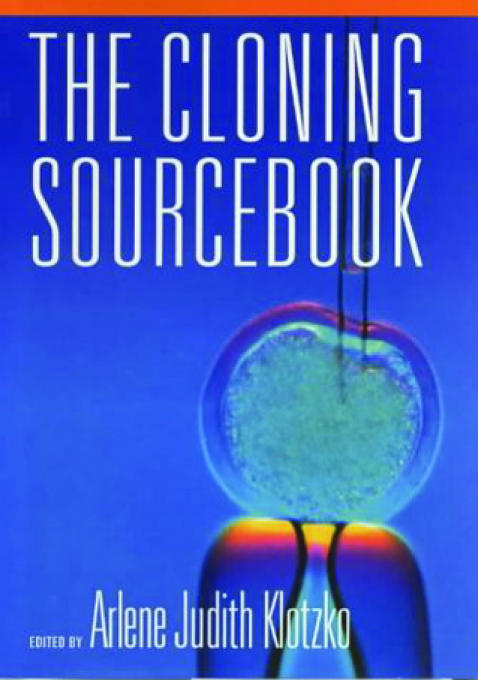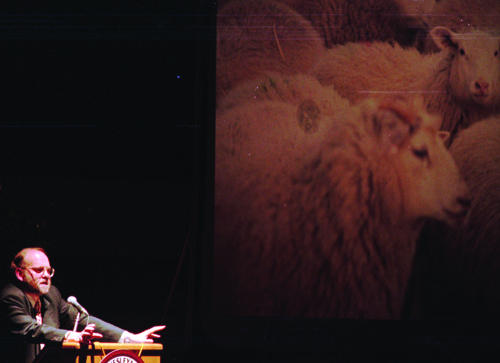 The Cloning Sourcebook. Ed Arlene Judith Klotzko. Oxford University Press, £27.50, pp 328. ISBN 0 19 512882 6. Rating: ★★★
The Cloning Sourcebook. Ed Arlene Judith Klotzko. Oxford University Press, £27.50, pp 328. ISBN 0 19 512882 6. Rating: ★★★
Any decision to proceed with human cloning ought to be taken by society and not by the enthusiastic scientists who devise and perfect the necessary techniques. Those, including the scientists, who doubt the capability of the public to make wise decisions, would do well to recall the opinion of Thomas Jefferson: “I know no safe depository of the ultimate powers of the society but the people themselves; and if we think them not enlightened enough to exercise that control with a wholesome discretion, the remedy is not to take it from them, but to inform their discretion by education” (Thomas Jefferson on Democracy, Mentor Books, New York, 1939).
The quality of the public debate on human reproductive cloning has not been of a high standard. A leading British bioethicist, John Harris, wrote after the birth of Dolly, the cloned sheep, that “the ethical implications of human clones have been much alluded to, but have seldom been examined with any rigour” (Journal of Medical Ethics 1997;23:353-60). He was critical of the almost hysterical, knee jerk opposition to reproductive cloning that had followed the triumph of Dolly's creator, Ian Wilmut, and his colleagues.
In The Cloning Sourcebook, Raanan Gillon examines the arguments against human reproductive cloning and concludes that a temporary ban is justified. The technique is, at present, unsafe and the technology is likely to be taken up by such a small proportion of the population that considerations of distributive justice would also support the ban. In addition, there has not been enough time for a full social debate on such a contentious issue. Gillon, like many other ethicists, does not believe that a cloned child would suffer harm because of knowledge about the life of the donor of the nucleus that gave rise to her. Nor is he swayed by arguments about the potential social harms that might result from reproductive cloning—harms such as racism, eugenics, mass destruction, or the violation of the security of genetic material. The danger to humanity's future is, says Gillon, not presented by the technology but, rather, by the social structures that would permit “the predations of the control freaks, whether they are the control freaks of state or religion or science or big business, or simply of crooked gangsters who seek to use us for their own ends.”
The Sourcebook contains an interesting account of the context in which cloning has occurred, with excellent analyses of the ways in which the media, on both sides of the Atlantic, has reported on cloning. In comparison with US newspapers British newspapers provided little scientific detail—not surprising if one considers that there are more science writers on the New York Times alone than on all British newspapers put together.
Relatively little attention is paid in the Sourcebook to the topic of embryonic stem (ES) cell research or therapeutic cloning, which holds out the promise of effective therapy for a host of diseases. It is permitted in the United Kingdom but it has been virtually outlawed in the United States. The Bush administration is strongly opposed to research that involves the “killing” of embryos, even if they are “surplus” byproducts of in vitro fertilisation programmes. Recently, however, President Bush approved the use of existing ES cell lines that have been established in the US private sector or in other countries. Cynics claim that this is because of the possible commercial benefits that may result from such research.
It is to be hoped that the general public, as well as health professionals, will read The Cloning Sourcebook and other publications dealing with the scientific and ethical aspects of cloning. We might then feel more confident that society will, in Jefferson's words, be “enlightened enough to exercise that control” over the future uses of cloning technology “with wholesome discretion.”
Figure.
DANIEL LUEDERT/AP PHOTO
Triumph: Wilmut and Dolly. But should human cloning be banned?



